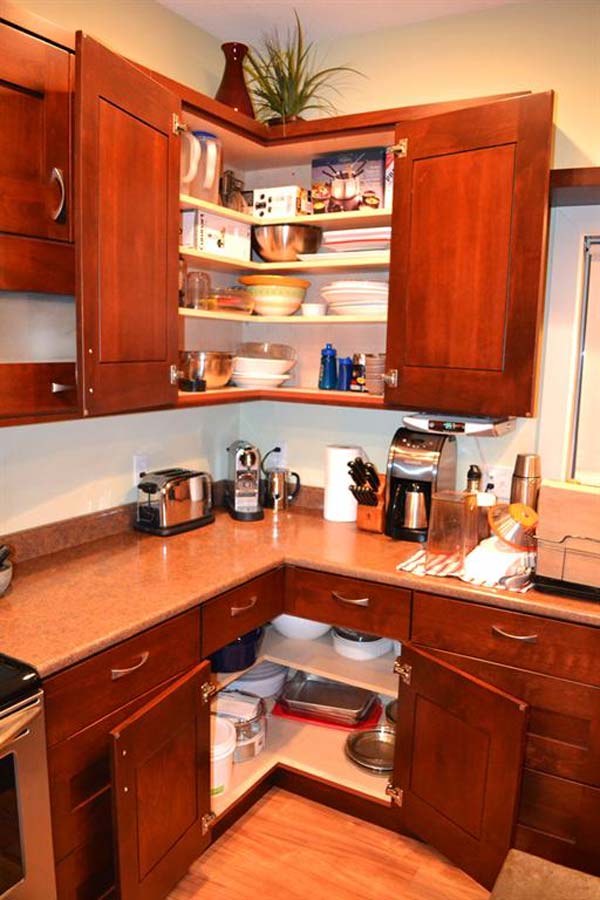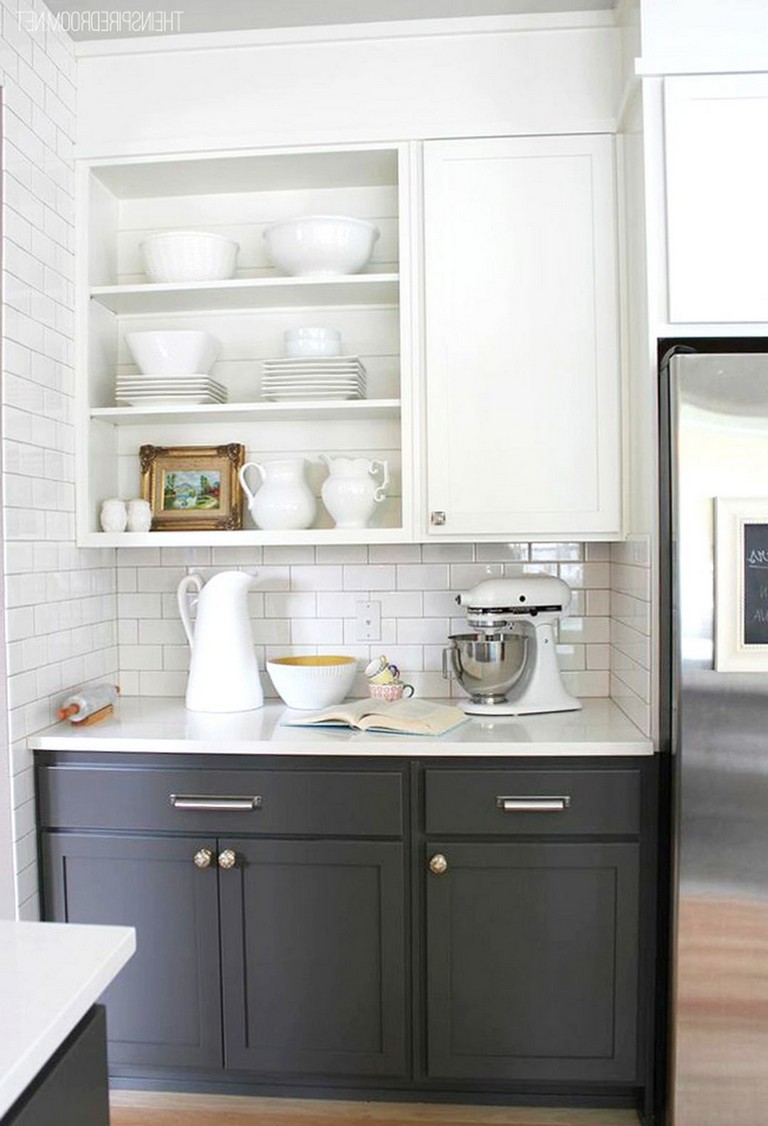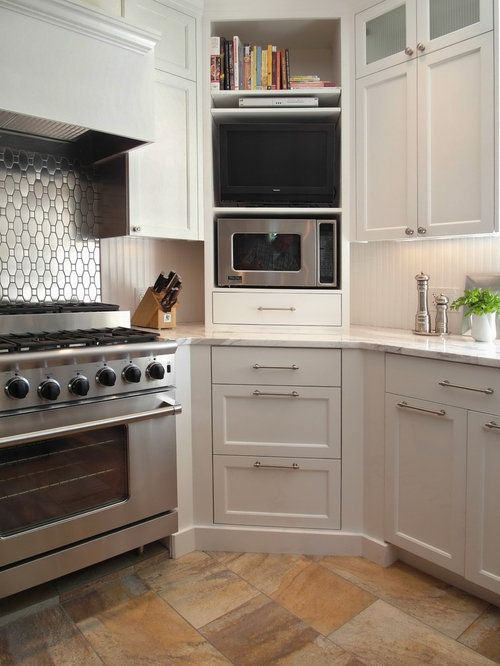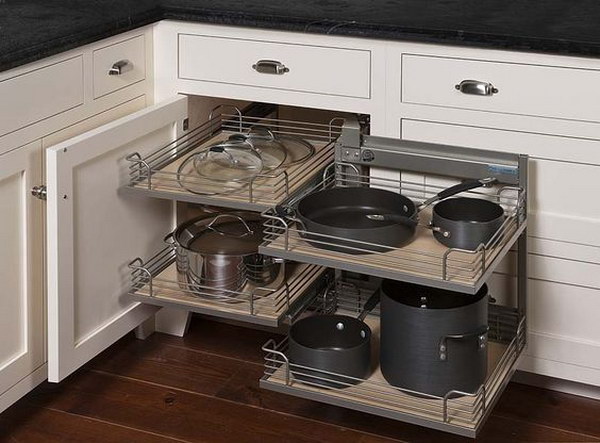When designing a kitchen, one of the most challenging spaces to utilize effectively is the corner cabinet area. Corners can be awkward and often become the least functional space in the kitchen, leading to wasted storage opportunities and inefficient use of space. However, with thoughtful planning and innovative corner kitchen cabinet ideas, you can transform this tricky area into a highly functional and aesthetically pleasing part of your kitchen. There are several approaches to corner cabinet design, each offering unique solutions to maximize storage, improve accessibility, and enhance the overall look of your kitchen.
One popular option for corner kitchen cabinets is the Lazy Susan. This classic design features rotating shelves that allow you to easily access items stored deep in the corner. Lazy Susans come in various styles, including full-round and kidney-shaped, and can be customized with multiple tiers to accommodate a range of kitchen items. The primary advantage of a Lazy Susan is its ability to make use of every inch of corner space, reducing the need to reach or bend awkwardly. This design is particularly useful for storing items like pots, pans, and small kitchen appliances, which can be cumbersome to retrieve from traditional cabinets.

Another innovative solution for corner cabinets is the swing-out or pull-out shelf system. These systems feature shelves that swing or slide out of the cabinet when the door is opened, bringing the contents directly to you. This eliminates the need to reach into the back of the cabinet, making it easier to access items stored in the corner. Swing-out and pull-out shelves are ideal for storing frequently used items like spices, baking supplies, and dishware. They can be customized to fit various kitchen layouts and are available in different materials and finishes to match your kitchen’s style.
Diagonal corner cabinets are another option for making the most of corner space. These cabinets are designed to fit diagonally across the corner, creating a more accessible and visually appealing storage area. Diagonal corner cabinets often feature a single, large door that opens to reveal a spacious interior, perfect for storing large items like mixing bowls, blenders, or cookware. The interior of the cabinet can be outfitted with adjustable shelves or pull-out trays to further enhance its functionality. While diagonal corner cabinets may reduce the overall storage space compared to other designs, they offer easier access and a more streamlined look.

For those who prefer a more modern and sleek kitchen design, corner drawers are an excellent choice. Unlike traditional cabinets, corner drawers are designed to pull out from the corner in a straight line, offering easy access to the entire drawer. This design eliminates the need to reach into the back of a cabinet and allows for more efficient use of corner space. Corner drawers are perfect for storing utensils, kitchen gadgets, or even pantry items. They can be customized with dividers, organizers, and soft-close mechanisms to enhance their functionality and usability.
If you’re looking for a way to make a bold design statement while maximizing corner storage, consider installing a corner cabinet with glass-front doors. Glass-front corner cabinets add a touch of elegance to the kitchen and create an opportunity to showcase beautiful dishware, glassware, or decorative items. These cabinets can be illuminated with interior lighting to highlight the contents and add a warm, inviting glow to the kitchen. In addition to their aesthetic appeal, glass-front cabinets encourage organization and neatness, as the contents are on display.

Another creative solution for corner cabinets is the use of angled or rounded shelves. Angled shelves are designed to fit seamlessly into the corner, creating a unique storage space that is both functional and visually interesting. These shelves can be installed inside a cabinet or as open shelving, depending on your preference. Rounded shelves, on the other hand, curve around the corner, providing a softer, more fluid look. Both options are ideal for storing items that you want to keep within easy reach, such as cookbooks, small appliances, or decorative objects.
Tall corner cabinets, sometimes referred to as pantry cabinets, are another effective way to utilize corner space, especially in larger kitchens. These cabinets extend from the floor to the ceiling, offering ample storage space for pantry items, small appliances, or even cleaning supplies. The interior of a tall corner cabinet can be customized with pull-out shelves, baskets, or bins to make it easier to access items stored at the back. This type of cabinet is especially useful for storing bulk items or kitchen essentials that you want to keep out of sight but within easy reach.
Another practical idea for corner kitchen cabinets is the installation of a blind corner cabinet with pull-out or slide-out shelves. Blind corner cabinets are designed with one door that opens to reveal a deep, hidden space. To make this space more accessible, pull-out or slide-out shelves can be installed inside the cabinet, allowing you to easily retrieve items stored in the back. This design is perfect for kitchens where space is limited, as it maximizes the available storage without requiring a large footprint.

For a more integrated and seamless look, consider incorporating corner cabinets with integrated appliances. This design approach involves installing small appliances, such as a microwave or coffee maker, directly into the corner cabinet. This not only frees up counter space but also creates a more streamlined and cohesive kitchen design. Integrated corner cabinets can be customized with built-in electrical outlets and ventilation to accommodate a variety of appliances, making them both practical and stylish.
If you prefer an open and airy kitchen design, open corner shelving might be the right choice for you. Open shelves installed in the corner of the kitchen create a sense of spaciousness and provide a convenient spot for storing frequently used items like dishes, glasses, or cookbooks. Open shelving also allows you to display decorative items, adding a personal touch to the kitchen. This design is especially effective in smaller kitchens, where closed cabinets can make the space feel cramped.
In kitchens with a more traditional or rustic design, a corner cabinet with a built-in wine rack can add both functionality and charm. Wine racks can be integrated into the corner cabinet, providing a convenient and attractive way to store and display your wine collection. This design not only makes efficient use of corner space but also adds a touch of elegance to the kitchen. The wine rack can be customized to hold a specific number of bottles and can be combined with other storage features, such as glass racks or drawers for wine accessories.

Corner sink cabinets are another option for utilizing corner space in the kitchen. Installing the sink in the corner frees up valuable counter space and creates a more efficient kitchen layout. Corner sink cabinets can be customized with pull-out shelves, tilt-out trays, or even integrated cutting boards to maximize storage and functionality. This design is particularly useful in smaller kitchens, where every inch of space counts. Additionally, corner sinks can be paired with corner windows to create a bright and airy workspace.
If you’re looking to add a touch of luxury to your kitchen, consider a corner cabinet with a built-in coffee or beverage station. This design transforms the corner of your kitchen into a dedicated space for brewing coffee, making tea, or mixing drinks. The cabinet can be outfitted with pull-out trays for coffee makers, storage for mugs and glassware, and even a mini-fridge for beverages. A built-in coffee or beverage station not only maximizes corner space but also adds convenience and style to your kitchen.
Finally, a unique and practical idea for corner kitchen cabinets is the installation of a corner pantry. A corner pantry is a small walk-in closet that occupies the corner of the kitchen, providing ample storage space for pantry items, small appliances, and kitchen supplies. The interior of the pantry can be customized with shelves, bins, and pull-out trays to keep everything organized and easily accessible. Corner pantries are especially useful in larger kitchens, where additional storage is needed, and they can be designed to blend seamlessly with the rest of the kitchen cabinetry.

Common Mistakes to Avoid
Ignoring Accessibility: One of the most common mistakes when designing corner kitchen cabinets is failing to consider accessibility. Deep corners can be difficult to reach, making it challenging to retrieve items stored at the back. To avoid this issue, consider using pull-out shelves, Lazy Susans, or swing-out trays that bring the contents of the cabinet directly to you.
Underestimating the Importance of Lighting: Proper lighting is essential for making the most of corner cabinets, especially those with deep storage spaces. A common mistake is neglecting to install adequate lighting inside corner cabinets, which can make it difficult to see and access items. Consider adding interior lighting or under-cabinet lighting to brighten up these areas.
Overlooking Customization Options: Corner cabinets offer a range of customization options, from adjustable shelves to built-in organizers. A common mistake is opting for standard designs without exploring these options, which can result in wasted space or inefficient storage. Take the time to consider how you can customize your corner cabinets to better meet your needs.
Neglecting Aesthetics: While functionality is key, it’s also important to consider the aesthetics of your corner cabinets. A common mistake is choosing a design that doesn’t complement the rest of your kitchen, resulting in a disjointed look. Make sure your corner cabinets match the style, color, and finish of your other cabinetry for a cohesive design.
Failing to Account for Future Needs: Another mistake is not thinking about how your storage needs might change over time. Corner cabinets that work well for your current kitchen setup might not be as effective if your needs change. Consider opting for flexible designs with adjustable shelves or modular components that can be adapted as needed.
Choosing the Wrong Materials: The materials you choose for your corner cabinets can impact both their durability and appearance. A common mistake is selecting materials that are either too heavy for the corner installation or that don’t hold up well to kitchen conditions. Choose materials that are both durable and appropriate for the style and function of your kitchen.

What is the best type of corner kitchen cabinet for small kitchens?
For small kitchens, space-saving options like Lazy Susans or corner drawers are ideal. Lazy Susans maximize storage in tight spaces by utilizing rotating shelves, making it easier to access items stored deep in the corner. Corner drawers, on the other hand, provide full access to the contents without the need to reach into the back of a cabinet. Both options are efficient and can help make the most of limited kitchen space.
How can I make my corner kitchen cabinets more accessible?
To improve accessibility, consider installing pull-out or swing-out shelves that bring items stored in the back of the cabinet to the front. Lazy Susans are also effective for making deep corner spaces more accessible. Additionally, customizing your corner cabinets with interior lighting can help you see and retrieve items more easily. These solutions eliminate the need to reach or bend awkwardly, making your corner cabinets more user-friendly.
Are corner kitchen cabinets suitable for housing appliances?
Yes, corner kitchen cabinets can be customized to house small appliances like microwaves, coffee makers, or even built-in refrigerators. This approach not only maximizes corner space but also creates a more streamlined and efficient kitchen layout. When designing a corner cabinet for appliances, consider factors like ventilation, electrical outlets, and the size of the appliance to ensure a proper fit and safe operation.

Can I install a sink in a corner kitchen cabinet?
Installing a sink in a corner kitchen cabinet is a popular option, especially in smaller kitchens where space is limited. Corner sinks can free up valuable counter space and create a more efficient kitchen layout. However, it’s important to plan for plumbing and ensure that the cabinet is designed to accommodate the sink and any additional features, such as pull-out trays or tilt-out bins, to maximize storage around the sink area.
What materials are best for corner kitchen cabinets?
The best materials for corner kitchen cabinets depend on your kitchen’s style, budget, and functional needs. Common options include solid wood, plywood, MDF, and laminate. Solid wood offers durability and a classic look but can be more expensive. Plywood is a durable and cost-effective alternative, while MDF and laminate offer a range of finishes and are more budget-friendly. It’s important to choose materials that can withstand the wear and tear of kitchen use while complementing the overall design of your kitchen.
How can I make my corner kitchen cabinets more visually appealing?
To enhance the visual appeal of your corner kitchen cabinets, consider options like glass-front doors, open shelving, or integrated lighting. Glass-front doors allow you to showcase decorative items or beautiful dishware, while open shelving creates an open and airy feel. Integrated lighting can highlight the contents of the cabinet and add a warm glow to your kitchen. Additionally, choosing finishes and hardware that complement the rest of your kitchen can help create a cohesive and stylish design.

Kitchen Corner Cabinet Storage Ideas

Related Posts:
- Little Greene Kitchen Cabinets
- How To Measure Your Kitchen For New Cabinets
- Interior Design Ideas For Kitchen Cabinets
- Harmony Kitchen Cabinets
- Best Kitchen Cabinet Ideas
- Metal Frame Kitchen Cabinets
- Chipboard Kitchen Cabinet
- How To Modernize Kitchen Cabinets
- Madison Kitchen Cabinets
- Changing Hardware On Kitchen Cabinets